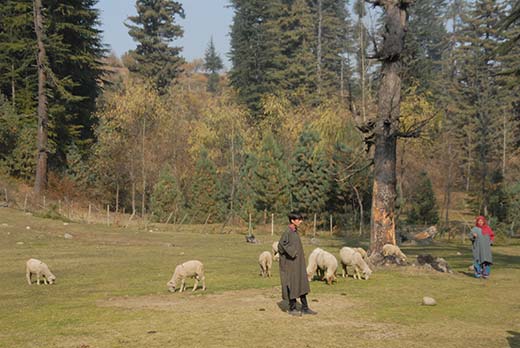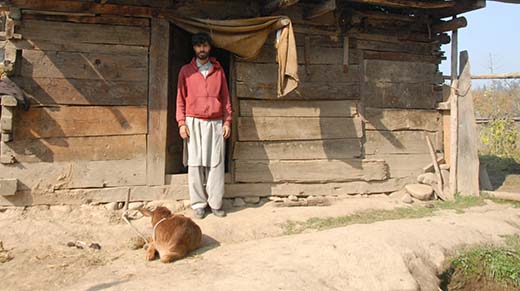A breathtaking view of a hamlet in north Kashmir’s Langate turns deceptive once its moment of truth unfolds. Much to one’s disbelief, the hamlet was turned into a mortuary besides a torture cell during nineties. Bilal Handoo relives the gory tales of death and destruction

Pic: Bilal Handoo
Deep in the jungles of north Kashmir’s Langate, there lies a heavenly hamlet called Doodh Kul. Towering pines and peaks, snow-white gushing streams and meditative stillness are striking features of the place. Some forty odd timber houses only add to its beauty. But just when the sight starts swaying senses, a reminder flashes: some appearances are deceptive!
A narrow serpentine track runs through trees and opens into a hamlet perched on a hillock. Just 14km from the main town Langate, Doodh Kul still cradles a remote life. Women and children wear wondrous eyes on their blank faces. They intermittently peek through small windows. Some pass shy smiles and disappear inside. Some stay hooked at windows with their unflinching gaze. And some offer puzzling looks, making one speculate: perhaps some alien is on prowl in their lovely hamlet!
But Doodh Kul doesn’t seem to house many such smiling and shy faces. Sad, sullen and serious faces dominate over the scene. Three woodcutters coming from the nearby woods flash a strange sneer. One middle-aged lady going to feed her pot from a stream downhill looks irked. And a young shepherd roaming around with his flock appears grave.
These unpleasant moods in an otherwise charming place strike a sense of ‘estranged wed-lock’ between the people and the place.
There is a man sitting near three timber houses on swathes of land atop a hillock. Even, this man looks sullen! Having a typical plaintive appearance, the man introduces himself: “My name is Mohammad Ashraf Mir.”
This 35 something man speaks in a dismissive tone. “Are you new here?” he quizzes, turning his face away. “Yes.” “Hmmm… so what bring you here?” “I just wanted to see the place.” “So how do you find it?” “The place is breathtaking, but I am confused about the people. Something seems wrong. You all look displeased…” “Okay, stop it!”
He turns his face back to me. One can see a bizarre rage overpowering him. “What do you know about this place?” he asks. I feign ignorance. And he hastens to divulge: “It is a haunted hamlet!”
He again turns his face away. And for a moment, only sounds of birds coming from nearby woods seemingly echo in the entire hamlet.
After a while, a few passing men join the conversation. These men mainly converse with each other in Gogri language, the mother-tongue of this Gujjar population of Doodh Kul. A heating-up fuss among these men suggests some of them aren’t ready to reveal their past, in fact, a ‘haunting’ past. But Ashraf along with two other men have no qualms to talk about the “qahar” or the doom.
“They would appear in dark, kill and depart. And then they would return few days after to resume killing and torture,” Ashraf begins. “They?” I interject. “Who else,” he rapidly replies, “than the Indian army!”
Ashraf is a lean man sporting unkempt stubble and hair. Facing the green pines from the front, he talks in broken Kashmiri. In between, he also speaks in Urdu, though not chaste, to overcome frequent faltering. “You know what they did?” he resumes. “Yes. They. Army. They came and painted the hamlet red. Family patriarchs of this hamlet became their target.”

Pic: Bilal Handoo
He turns his face to his right and catches glimpse of a nearby house. Two cows are peacefully eating grass there. Nearby, a small girl is sweeping her doorsill. Besides, a small boy is playing, alone. Rest, the hamlet appears peaceful amid the looming desolation.
“Of 30 odd families living in this hamlet in nineties, men of 20 odd houses fell to bullets,” resumes Ashraf. “Army ne kohram macha diya tha yaha pe (Army spelt doom here)!”
The “doom” that fell on Doodh Kul spared none. Besides it has a name: “Army’s late night prowl!”
“My two brothers were also devoured by the doom in early 2000,” he finally let out his personal pain.
Sumander Mir was the man of his only kind in Doodh Kul. He was just one call away for his people. At 40, he had a swiftness and strength of an athlete.
In one night in 2002, this eldest of Mir brothers woke up to attend the late night knocks that repeatedly thudded the main door of his house. The moment he opened the door, somebody pushed him back. “It was army who shoot him dead on spot,” Ashraf recalls. “Later army justified the act by claiming recovery of arms from my dead brother.”
That night, army left Sumander’s seven shrieking orphans behind.
But the deadly knocks didn’t end with Sumander’s killing itself. In 2005, it was déjà vu for Mirs. A posse of army again showed up one night and took Ashraf’s another brother Ghulam Ahmad Mir, 35, for seeking direction in nearby woods.
When that dark night ended with the arrival of the next day, Mirs began search, which shortly ended in bereavement. “Four days later,” Ashraf says, “we found his throat-slit body lying abandoned in nearby Chuhe canal.”
But Ashraf’s brothers weren’t the first who were done to death in Doodh Kul. It was 40-year-old Abdullah Mir who was the first man to lose his life to Army’s “late night prowls” in Doodh Kul, the locals say. That first killing happened in 1993. Mir was found dead at Dugar village, 15km away from the hamlet. The killing sparked off a great distress in an otherwise idyllic hamlet. “That killing simply unleashed hell over this hamlet,” says Gulzar Mir, 37, a tall and well-built shepherd. “The torment hardly stopped after that.”
By 1995, Abdullah Mir’s younger sibling, Abdul Gani Mir too fell to bullets in Shilthar, 3km away from the hamlet. Both brothers had left behind families full of toddlers.
Later that year, one Mohammad Shafi Mir, 25, got disappeared. He is still untraced.
Besides killings, bonded labour ran parallel in the hamlet. Known for doing maize farming, people of the hamlet had a new task to shoulder during nineties: Army begaeir!
“Failing to turn up for the begaeir would wreak havoc for us,” continues Gulzar, sitting on a huge rock in the middle of a meadow planted with pines. “There was no way out for us.”
All this happened because army had a special focus on Doodh Kul, Gulzar says: “Somehow army sniffed that many men in this hamlet are underground workers of Al-Barq.”
Al-Barq was the militant outfit of People’s Conference (PC). It was led by the slain unionist-turned-separatist leader, Abdul Gani Lone. When guns started roaring in nineties, PC openly boasted of its own armed outfit. To send a strong message, PC swiftly changed its ‘lion’ into ‘gun’. And soon, people joined the outfit in droves. The outfit witnessed massive involvement from north Kashmir’s Kupwara district. “Behind the large participation was the popularity of the Lone Sr in the region,” Gulzar says. “As the spill-over reached Doodh Kul, a few men also joined Al-Barq for the sake of their beloved leader, Lone Sahab. But they later quit.”
Nazir Ahmad was one among those who had joined Al-Barq. He is now an elected sarpanch of Herel, a neighbouring village of Doodh Kul.
At 48, Nazir has a stark sober appearance. He talks loud and openly boasts: “I am the only one here who still talks about martyrs.”
But after divorcing militancy, remarrying mainstream and parenting village welfare, Nazir now blames his parent outfit, Al-Barq for the devastation of Doodh Kul. “Among those slain twenty men of Doodh Kul, three were my close relatives,” he says. “People of this hamlet too had a soft corner for Al-Barq, but they were not Mujahids as such.”
Now when PC’s party symbol has changed from ‘gun’ to ‘table’, Nazir rues: “Those who triggered bloodbath in this hamlet have now made peace and pact with killers!”
But apart from Al-Barq factor, Doodh Kul was especially made to suffer for the mass mobilisation of 90s. Thousands of Kashmiris trekked the “track of Azadi” that ran through the jungles of Doodh Kul. It was believed to be the shortest path to reach Muzaffarabad for arms training. Tut Mar Gali (TMG) on line of control is 70km from the hamlet.
While going or returning from Pakistan administrated Kashmir, those men would often stay for a night at Doodh Kul, says Idrees Malik, 43, a witness of such moves: “Those armed men would stop here, take rest, dine with us and leave.”
At the outset, all went well. But after Indian army sniffed such movements, the hamlet became the target. “We were trapped in a helpless situation,” Malik continues. “Our irony was that: we couldn’t deny entry to armed men in our houses. But then Indian army made it a point and turned our lives hell.”
Shortly after the revelation, Doodh Kul was apparently turned into a garrison. To escape the army’s wrath, almost everyone abandoned their homes and migrated to neighbouring villages. But once they returned, they received their share of pounding. Today, not a single family exists in Doodh Kul without having a torture history.
Many still shiver while recalling the torture methods introduced by “14 Dogra Army” in the hamlet. “Army men of that battalion would light up fire and torture men, women and even children with it,” Malik continues. “They would force us to drink water. And then punch hard on our bellies to vomit it.”
People recount the names of many “dreadful” army majors who had unleashed a “reign of terror” over the hamlet. But the name of one major Ramaya is on everybody’s lips in Doodh Kul for his “ruthless torture” methods. Many of them say: “Su ous bade zaalim (He was very ruthless)!”
“That major would cut flesh from a person’s body with a sharp knife,” claims Malik, “and then add salt and pepper on the wound before covering it with a bandage. This would leave the person in an excruciating pain.”
But the period of torture didn’t end there. Army would also take men of the hamlet for night patrolling on rotational basis, claims Mushtaq Ahmad, a local. “Every night, 8 new men would be taken to the task,” he continues. “Life in those days was simply terrible.”
To escape army’s wrath, four youth volunteered themselves for Territorial Army services, he says: “Many more could have joined army to end a torturous life, but not everyone met their terms and conditions.”
When all this was happening, the school education faced a huge setback in Doodh Kul. A neighbouring school in Herel had been turned into a torture centre. “Army wouldn’t allow children of this hamlet to attend schools,” says Iqbal Bhat, another local. “As a result, the hamlet never excelled in education.” So far, he says, only two boys have made to Class 10.
Two decades later, the normalcy has returned to the hamlet, where Mirs, Sheikhs and Maliks live in a close-knit community. But education, employment and economy remain elusive in the place. “With prevailing poverty and least educational prospects available,” says Ghulam Hassan Sheikh, the first government employee of this hamlet, “youth of this hamlet are mainly into farming or work as labourers.” Amid all this, Doodh Kul is still craving for a single teacher and doctor.
The doomed days are over. But the peaceful posturing of present hasn’t undermined its dreadful past. Memories are still trailing a gloom behind. Sad, sullen and serious faces don’t confuse after the truth unfolds. Amid deceptive appearance, Ashraf Mir is still sullen. That lady with water pot continues to be bitter. And that roaming shepherd still wears those grave looks. And those woodcutters are finding it hard to smile.
Perhaps, this dagh (pain) of Doodh Kul, is too huge to lessen up.















